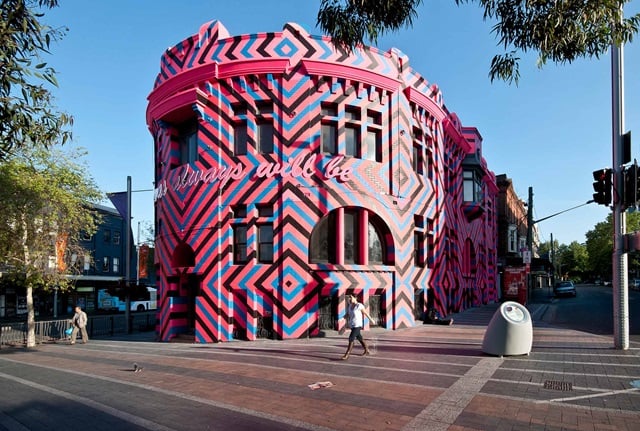

Amplified survey language was used to interpret the path of the Tank Stream, questioning the origins of public space and its function.
Curator: Steffen Lehmann
Artwork description
PS: Potential Spaces was a collaboration between 3 disciplines – law, architecture and art. The installation made apparent the ‘invisible’ legal framework of Tank Stream Way and Hamilton Street, originally a single continuous street built directly over the path of the stream.
The installations interpreted the path of the Tank Stream, making reference to historical records such as property and planning boundaries, and written descriptions and paintings of the area. This information was translated onto the laneways through an interpreted or amplified survey language.
This included brightly coloured road paint, custom bronze survey markers inserted into the road and footpath surface and iridescent ropes with pendant fittings hanging like a traditional surveyor’s tool – the plumb bob and string. Standard City of Sydney planter boxes were also redeployed as lounges for seating. Making reference to the original nature of the site they were also planted with small trees and shrubs that were native to the area when the road was once a lush and fertile river bed.
The bronze survey markers embedded in the laneway contain symbolic references to the elements that formed the site over time. With its history as the main fresh water source of Sydney, the Tank Stream provided an element of demarcation, firstly between classes of convicts and later between parishes.
A bottle washing yard and steam biscuit manufacturer also became prominent features of the street. While relating to these specific historical elements, the shell and bottle are symbols of fresh food and water, but also of discarded empty vessels, as early settlers began polluting the stream, turning it from water source to sewer and resulting in the eventual covering over of the stream. In a trans-historical gesture, the contemporary markers quote John Hamilton of the Steam Biscuit Bakery, who in a letter from 1861 noted as the Tank Stream was being covered over, “The street is now being formed”.
The installation provided a bright and festive seating area for the public to gather over the summer months. The Chalk Horse artists on the team did a number of pop-up events and performances during the period of the installation. Certain elements of the work such as the road paint and custom bronze survey markers were left behind after the work was dismantled, to encourage further questioning of the type of space the laneway could be.
“Laneways are often a vestige of early white settlement and the titles associated with them, interesting and complex. The application of property and planning laws often takes time to work out.
Who is actually responsible for these city rooms? How public are they and what can we, the public, do in them?”
– Artist statement, 2009
Project team
- Rachel Neeson, Nick Murcutt, Isabelle Toland – Neeson Murcutt Architects
- Jasper Knight, Dougal Phillips, Oliver Watts – Artists, Chalk Horse
- Harshane Kahagalle – Solicitor, Freehills







